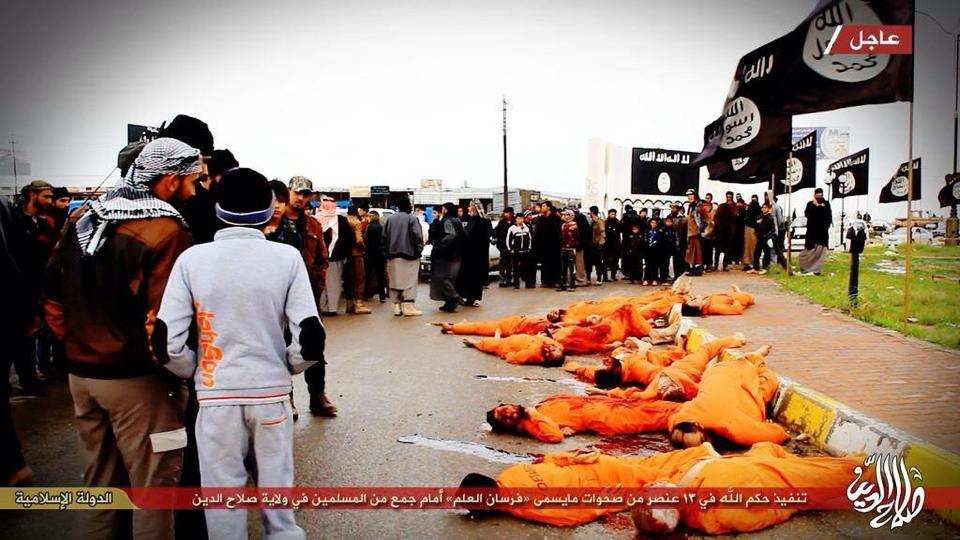No matter how many bombs Americans drop on ISIS forces, Iraqi troops are losing ground. If al-Anbar is lost, the entire Iraqi front dynamic will shift to favor ISIS again, and months of the U.S.-led air campaign will have been wasted.
Maybe that’s why we had reports from an Iraqi field commander on Tuesday that U.S. forces had their first ground clash with ISIS terrorists at midnight on Monday, Baghdad time. ISIS fighters were forced to withdraw after U.S. air force fighters bombed enemy positions.
Related: 9 ISIS Weapons That Will Shock You
The minor victory was well timed. After six weeks of defeats in Iraq, ISIS made its first gains in the western province of al-Anbar last week, threatening the remaining Iraqi government forces and its tribal Sunni allies who are defending the remaining cities and army camps there.
“We have ammunition to fight ISIS for five days only. After that, we will not be able to fight them with their advanced arms,” said Sheikh Naeim al-Gaud, a tribal leader who suffered hundreds of losses in a massacre committed by ISIS several weeks ago near the city of Hit, western Iraq.
A lot is riding on Al-Anbar. It’s Iraq’s largest province, about one-third the size of Iraq. It borders Syria, Jordan and Saudi Arabia. It also borders Baghdad, Babil, Karbala, Najaf, Salahuddin and Nineveh provinces. Most of the province is controlled by ISIS. Nevertheless, the provincial capital, Ramadi, is divided between the Iraqi government and ISIS. Several other towns are still controlled by the government as well, including an army camp that hosts 100 U.S. soldiers.
On the days following al-Gaud’s warning, ISIS retook many areas to the west of Ramadi, near the town of al-Baghdadi, forcing the army and its allies to halt an attack to restore the city of Hit. Shekh al-Gaud said he only received 72 AK-47 rifles that are out of service despite his public appeals for help. He also said that the army’s seventh division, which is fighting ISIS in his area, has no tanks at all while ISIS has many of them. His tribal fighters used rocket-propelled grenades, or RPGs, to counter ISIS tanks. That is no longer working. “They have developed a way to make their tanks avoid our rockets.”
Related: The Merger of ISIS and al-Qaeda Could Cripple the Civilized World
He lost 762 members of his tribe who were killed by ISIS.
One of the reasons the Iraqi government hesitates to arm the tribes in al-Anbar is that some of the weapons sent previously ended up in ISIS hands. “I was told that 4000 Russian PKCs heavy machine guns were sent before. 800 of them ended up with ISIS,” al-Gaud said.
 To make a bad situation worse, al-Anbar’s provincial council fired the governor. The governor was injured three months ago while fighting ISIS and has been on sick leave ever since. He went to Baghdad to dispute the decision in court. Al-Anbar’s tribes sent two delegations recently to ask for weapons -- one to the U.S. and another to Iran. They also tried to buy weapons from the local black market.
To make a bad situation worse, al-Anbar’s provincial council fired the governor. The governor was injured three months ago while fighting ISIS and has been on sick leave ever since. He went to Baghdad to dispute the decision in court. Al-Anbar’s tribes sent two delegations recently to ask for weapons -- one to the U.S. and another to Iran. They also tried to buy weapons from the local black market.

The situation is not much better in other parts of Iraq. A huge part of the Iraqi state’s assets was allocated to facilitate and protect the annual religious march of millions of Iraqi and Iranian Shiite pilgrims to the holy city of Karbala. The ritual commemorates 40 days from the anniversary of the martyrdom of Imam Hussein, the Prophet Mohammed’s grandson, who was killed in the seventh century.

Exploiting that opportunity, ISIS launched an attack aimed at the holy city of Samarra to the north of Baghdad. Most of the attack was repelled. However, it provoked the Shiite cleric Muqtada al-Sadr to order a full alert of his militia to prepare for Jihad to protect Samarra from danger. It was a situation similar to this in February 2006 that started the sectarian war in Iraq.
Related: How ISIS Wages a Brutal and Hideous War on Women
In its Sunni-controlled cities, ISIS brutality is escalating. In the town of al-Alam, in Salahuddin province to the north of Baghdad, ISIS executed 13 Sunni men in public. Another hundred were taken prisoner and face a similar fate. “This is ISIS’ revenge for resisting them. They kidnapped about 150 members of my tribe,” said Nazal al-Jbara, a local tribal sheikh of al-Jobur tribe. Similar executions are taking place elsewhere.
In Mosul, ISIS started to dig a trench around the city to protect it from a future attack. The Iraqi government has recently established the Nineveh Liberation Command. Several thousand men are training in camps in Kurdistan to join the expected attack.
Mosul’s last governor before the fall of the city went to the U.S. asking for help in arming the local former police force to liberate the city. “They are preparing for the battle of liberating Mosul. They are trying to dig a trench of two meters in depth and two meters in width around the city,” said Rachel Corrie, a blogger from Mosul.
ISIS’ recent gains prove that the terror organization is still able to surprise the Iraqi government forces and the entire U.S.-led alliance that is backing Iraq with more successful attacks. The Iraqi government forces were doing well in general except for al-Anbar – but they are still facing the ongoing problem of holding the territories they clear.
While everybody is acknowledging the devastating effect of the U.S.-led air bombing on ISIS targets, many think it needs to increase it, at least in al-Anbar.
The risk in losing al-Anbar is extremely costly, going back to the early days of the conflict when Baghdad’s fate was questionable. One hopeful sign – or oddity, depending on how you see it – is that the war against ISIS has brought two other enemies together. Shiite militias have been accepted by Anbar’s Sunnis to fight ISIS. United they stand, at least for now.
Top Reads from The Fiscal Times:





